More details are beginning to emerge in the controversy over what is now suspected to be a newly discovered work by Leonardo da Vinci. Initially, the name of the Manhattan art dealer who first sold the work was kept out of the news, but she has now come forward, and remains completely unconvinced that Leonardo had anything to do with the painting.
Kate Ganz purchased the painting at auction at Christie's for $21,850 and sold it to Downey Holdings--a company with an address somewhere in the British Isle of Jersey-- in January 2007 for the same price, less a dealer's discount. Peter Silverman, a Canadian art collector who advises Downey Holdings, told them the work was reminiscent of a Leonardo. Silverman never mentioned Ganz' name in his account, which he said was a measure to protect her anonymity (since it could be kind of embarrassing as an art dealer to make such a big mistake).
Ganz has now come forward as the original purchaser of the painting. She has also confessed to the New York Times that she remains unconvinced about the painting's authorship: “At the end of the day, when you talk about connoisseurship, it comes down to whether something is beautiful enough to be a Leonardo, whether it resonates with all of the qualities that define his handwriting — sublime modeling, exquisite delicacy, an unparalleled understanding of anatomy — and to me this drawing has none of those things.” Said Ganz. She went on to say that “Even though I honestly do not know what this drawing is, I still believe that it is not a Leonardo.”
The evidence in favour of the painting being by Leonardo still seems rather flimsy, which is why it's important that art critics agree on the authenticity of the painting. Thanks to carbon-14 dating, we now know that the painting was done sometime between 1450 and 1650. There is also substantial evidence that the artist was left-handed. The strongest evidence so far remains Lumiere Technologies digitization of the painting, which is supposed to reveal a number of similarities between Leonardo's style and this work.
Situations like this always make me wonder: 1. How often authentic works are passed over, and 2. How often fakes are agreed on by art critics to be the real thing. I'm sure both situations occur fairly often. After all, critics are embarrassed that they didn't recognize the age of the painting, so many seem eager now to conclude that it's the real deal. I'm really curious to see what the final verdict will be.
I still think that if I were the Swiss Collector, I'd insure my painting for an obscene amount of money, and then have it disappear mysteriously, a la "How to Steal a Million!"
Saturday, August 30, 2008
Debate Rages Over Possible Leonardo
Posted by
Margaret
at
10:12 AM
11
comments
![]()
![]()
Labels: news
Friday, August 29, 2008
200th Blog Post

It sort of sneaked up on me, but today marks my 200th post on this blog! Working on The Earthly Paradise has been such a wonderful experience. I've especially enjoyed working on the blog since graduating from my MA programme this summer. I think being able to write every day has definitely helped ease me into "the real world." I don't think I could ever bear to quit University cold turkey! Doing research for my blog helps me to feel like I'm still in school (which, for me, is a good thing).
Thank-you so much to all of you who stop by here to read my blog. And thank-you for your amazing comments! I enjoy reading so many of your blogs--each of them have introduced me to a new aspect of the world. I look forward to doing this for a long time!
This picture was taken this spring while I was in beautiful France with my mom. The lovely village of Dinan is in the background (thanks, mom, for reminding me where the picture was taken!).
Posted by
Margaret
at
9:57 AM
13
comments
![]()
![]()
Labels: blogging
Thursday, August 28, 2008
Tasha Tudor

Gillian's blog, Reflections in the Afternoon, reminded me a few days ago that Tasha Tudor's birthday was today! There has been a concerted online effort to pay special tribute to Tasha's birthday this year, which seems to have been led by the delightful Story Book Woods .
Tasha Tudor is one of my favourite illustrators of all time, and I was saddened when I heard back in June that she'd passed away. She was an incredibly prolific artist, with a body of work covering more than half a century. Tudor received her first Caldecott Honor for Mother Goose in 1945, and her last book, Corgiville Christmas, was published in 2003.
Tudor was born in 1915, but the era she aspired to was one even earlier--the 1820s. I think it would be inappropriate to say that she was nostalgic for an earlier era. Webster defines nostalgia as "wistful or excessively sentimental yearning for return to or of some past period or irrecoverable condition." But Tasha Tudor did not just yearn for the past, she painstakenly recreated a world that reflected the best of the time period she loved so much. She reminded readers about the beautiful customs of the past and helped keep them alive through classics like A Time to Keep, which celebrated family holiday traditions. I think many of my family's most treasured holiday "traditions" were borrowed from this fabulous book.
For more information on Tasha Tudor, or to purchase her lovely books, I recommend a visit to Tasha Tudor and Family. The site, which is run by Tasha's family, is a treasure trove of her lovely work. You can even by some of her original sketches and paintings here! Alas, I'm usually reduced to window shopping, but it's a fabulous, regularly updated site with information on upcoming events in the New England area.
Posted by
Margaret
at
5:57 AM
11
comments
![]()
![]()
Labels: tasha tudor
Wednesday, August 27, 2008
Review: How to Steal a Million
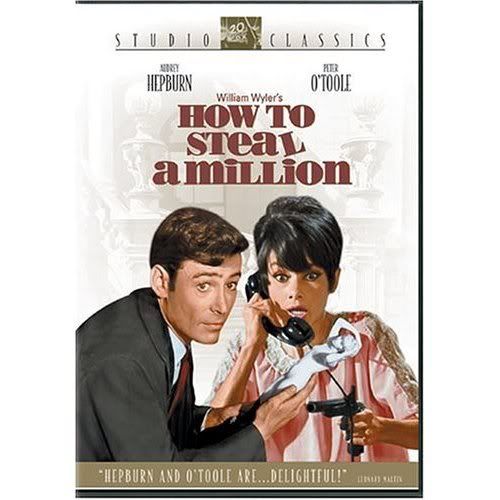
After reading a great post on Art Blog by Bob about famous forger, Han van Meegeren, I was reminded of the 1966 William Wyler film How to Steal a Million, starring Audrey Hepburn and Peter O'Toole. It's an art-heist romantic comedy featuring some great performances.
Audrey Hepburn stars as Nicole Bonnet--a hard-working, earnest young woman who whose father, Charles Bonnet (a delightful Hugh Griffith) just happens to be a brilliant art forger who's made a fortune passing his work off as originals by old masters. One night while her father is out for the evening, Nicole discovers a rather well-mannered burglar (Peter O'Toole) who appears to be stealing one of her father's paintings. After accidentally shooting him, she drives him home so that the police won't be called (the paint is still drying on the canvas of the fake Van Gogh that O'Toole appeared to be stealing).
Later, Nicole's father Charles receives a visit from a museum that wants to borrow the family's "Cellini Venus"--the sculpture that forms the foundation of the Bonnet family's reputation as great art collectors. Charles signs a form insuring the sculpture for 1 million dollars, only to discover that in doing so he's effectively consented to have the sculpture tested to insure its authenticity. After confessing to his daughter that the sculpture is a fake, sculpted by her grandfather, with her grandmother posing--"before she started having those enormous lunches!"--Griffith's character panics, fearing the sculpture will be exposed as a fake and destroy his reputation.
Nicole reassures her father that she has an idea: she'll enlist the help of the burglar she's met (Peter O'Toole) in order to steal the sculpture back from the museum, before they can finalise the tests. What follows is a humorous caper film, filled with great views of Paris (the old Hotel Ritz, in particular). Hepburn also sports a memorable, elegant Givenchy wardrobe. The film is great, light-hearted fare. Eli Wallach puts in a particularly memorable performance as a crazed art collector who will do anything to get his hands on "the Venus."
The following scene takes place at Nicole Bonnet's mansion, after O'Toole's character has broken in to test one of her father's paintings.
Image courtesy Amazon.com
Posted by
Margaret
at
6:46 AM
8
comments
![]()
![]()
Labels: film
Tuesday, August 26, 2008
Rossetti: His Life and Works by Evelyn Waugh
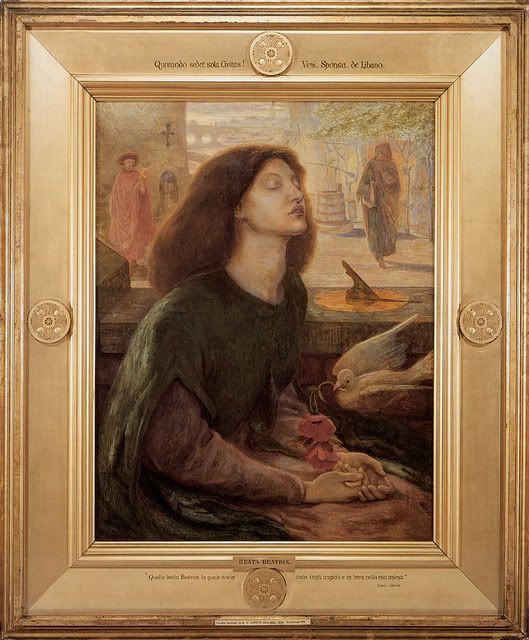
It seems like whenever I begin to imagine that I have unique, individual, interests and tastes, I am at once brought crashingly down to earth with the discovery that my likes and dislikes are downright predictable. It's like those lists on Amazon.com "other readers also bought:", where I'm always irked that I actually AM interested in the books they recommend. But however much I'd love to be one of those independent thinkers with wildly unpredictable tastes, it seems the more wildly different my tastes seem to be, the more they are somehow interconnected.
Take, for example, my interest in Evelyn Waugh. I've loved his witty novels for some time, but I only recently discovered that he had a passionate interest in the Pre-Raphaelites. I really was sort of surprised. I would have thought the Pre-Raphaelites far too modern for Waugh, but it seems I was mistaken. In fact, Waugh's first book was actually a biography of Dante Gabriel Rossetti, entitled Rossetti: His Life and Works.
The book has all the wit of Waugh's novels and is a delightfully gossip-filled take on Rossetti's life. Through numerous anecdotes, Waugh paints a portrait of Rossetti as an extremely talented, self-absorbed individual with a great appreciation for beauty, but an even greater capacity for self-pity. I found one aspect of Rossetti's story particularly telling: all of the writing about Rossetti make it clear that he was an animal lover who amassed great collection of exotic pets. What I did NOT know previously was that most of the creatures Rossetti kept in his menagerie perished almost as soon as they were brought home.
It does not appear that Rossetti lavished any personal affection upon his various pets, except perhaps upon the first of the wombats; he met their frequent deaths and disappearances with fortitude; some indeed died or disappeared almost the moment they were acquired...(Waugh, 117-118).
True to Waugh's usual form, the female characters in Rossetti's life get little attention compared to the males that populate his story. Nevertheless, I got the distinct impression that part of the reason they get such short shrift in Rossetti's biography is that they were genuinely not all that important in his life--more ornamental and muse-like than anything else. In fact, it seems that most of Rossetti's lovers were not treated much better than his pet wombats. Lizzie Siddal fared particularly badly, having been discovered by Rossetti when she was young and beautiful, only ot be gradually neglected over time.
Of course, despite neglecting Lizzie during her lifetime, Rossetti was inconsolable after Siddal's death from consumption. During a fit of remorse, be famously interred his poetry with her in her coffin, only to have her dug up again so that he could rescue his writings when his grief had run its course and he had bills to pay.
Never one to miss a chance to judge historical actors, Waugh concludes his little book with a chapter entitled "What is Wrong with Rossetti?" In which he decides that Rossetti's "problem" was his incurable romanticism.
In Rossetti's own day, no doubt, not a little of the adulation he aroused came from this romance of decay--a sort of spiritual coprophily characteristic of the age. Even now we are inclined to think of him with melancholy tolerance and to say, "If he had not been improvident and lethargic, how great an artist he might have been," as we say of the war poets, "If they had not been killed..." But it seems to me that there we have the root cause of Rossetti's failure. It is not so much that as a man he was a bad man--mere lawless wickedness has frequently been a concomitant of the highest genius--but there was fatally lacking in him that essential rectitude that underlies the serenity of all really great art. The sort of unhappiness that beset him was not the sort of unhappiness that does beset a great artist; all his brooding about magic and suicide are symptomatic not so much of genius as of mediocrity. There is a spiritual inadequacy, a sense of ill-organisation about all that he did.
But if he were merely a psychopathic case and nothing more, there would be no problem and no need for a book about him. The problem is that here and there in his life he seems, without ever feeling it, to have transcended this inadequacy in a fashion that admits no glib explanation. Just as the broken arch at Glastonbury Abbey is, in its ruin, so much more moving that it can ever have been when it stood whole and part of a great building, so Rossetti's art, at fitful moments, flames into the exquisite beauty of Beata Beatrix. It is the sort of problem that modern aesthetics does not seem capable of coping with. It has been the object of this book to state, though, alas! not to solve, this problem. (Waugh, 226-227)
I really enjoyed this book, which is hardly surprising, since I'm a fan of both Waugh and the Pre-Raphaelites. But I think almost anyone with an interest in Rossetti would really enjoy reading all of the letters and anecdotes that Waugh gathered together. And, while my review focuses on the more depressing aspects of Rossetti's life, there were many bright points worth mentioning as well. I'll have to mention those another day!
Evelyn Waugh. Rossetti: His Life and Works. London: The Folcraft Press, 1969.
Posted by
Margaret
at
11:07 AM
8
comments
![]()
![]()
Labels: books, lizzie siddal, rossetti
Monday, August 25, 2008
Rossetti's The Girlhood of Mary Virgin 1849
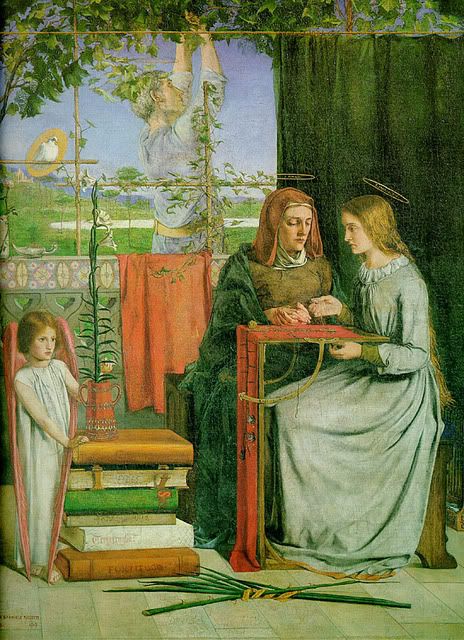
Dante Gabriel Rossetti was just twenty years old when his painting Girlhood of Mary Virgin was first exhibited on March 24, 1849. It was the first work to include the initials "P.R.B.", clearly visible in the lower left-hand corner of the canvas (click here to see a larger version of this painting at the Art Renewal Center).
I find it very interesting to see how much Rossetti's style changed throughout his life. This painting clearlly ties in with medieval and early rennaisance art, though the near photographic precision of the painting is quite modern (for more on the Pre-Raphaelite's combination of medieval style with modern techniques, see Barringer, 8-11). Devices like the haloes above Mary and her parents, Joachim and Anna (with the Latin form of their names inscribed on the inside--Rossetti writes "S.Maria" on Mary's halo) would have seemed instantly strange and archaic to Victorian viewers, who were not used to seeing paintings so steeped in symbolism.
Rossetti composed the following poem to accompany the painting. It was included in the exhibition catalogue. Notice how Rossetti has used his writing to help explain the symbolism in the painting to his viewers:
I.
This is that blessed Mary, pre-elect,
God's Virgin. Gone is a great while, and she
Dwelt young in Nazareth of Galilee.
Unto God's will she brought devout respect,
Profound simplicity of intellect,
And supreme patience. From her mother's knee
Faithful and hopeful; wise in charity;
Strong in grave peace; in pity circumspect.
So held she through her girlhood; as it were
An angel-watered lily, that near God
Grows and is quiet. Till, one dawn at home,
She woke in her white bed, and had no fear
At all, -- yet wept till sunshine, and felt awed;
Because the fulness of the time was come.
II.
These are the symbols. On that cloth of red
I' the centre is the Tripoint: perfect each,
Except the centre of its points,to teach
That Christ is not yet born. The books -- whose head
Is golden Charity, as Paul hath said --
Those virtues are wherein the soul is rich;
Therefore on them the lily standeth, which
Is innocence, being interpreted.
The seven-thorn'd brier and palm seven-leaved
Are here great sorrow and her great reward
Until the end be full, the Holy One
Abides without. She soon shall have achieved
Her perfect purity: yea, God the Lord
Shall soon vouchsafe His Son to be her Son.
-- D. G. Rossetti
I love the way Rossetti constructed his little puzzle for the viewer to decipher through a combination of image and text. Lines like "[u]ntil the end be full, the Holy One Abides without"--referring to the dove, which symbolises the Holy Spirit--provide clues for viewers that might not immeadiately pick up on all the symbolism.
Source consulted: Tim Barringer, The Pre-Raphaelites. London: Everyman Library, 1998.
Posted by
Margaret
at
9:18 AM
5
comments
![]()
![]()
Labels: pre-raphaelites, rossetti
Sunday, August 24, 2008
"The Anglo Files" by Sarah Lyall
It's amazing how wildly our preconceived notion of a place can differ from the way it is in reality. A friend of mine moved to Great Britain a while ago and was completely shocked at the wide gulf that separated literary England from contemporary England. She had expected the British to resemble characters from the novels in Jane Austen, and in reality, those she encountered bore a far more striking similarity to the cast of East Enders.
I still remember one of our first phone conversations after her arrival in Britain:
"Margaret, England is awful! I hate it here! I don't know what I was expecting, but I thought they would at least be well educated! But they all drink too much, have terrible grammar and bad manners and all they seem to care about is football!"
Unfortunately, my dear friend was expecting the England that most of us become familiar with through historical dramas--a pristine land teeming with Oxford-educated gentlemen: tee-totaling tea-drinkers, clad in argyle with better English than the Queen (I put this confusion down to watching too many episodes of Masterpiece Theatre and not enough soccer/football games!).
While journalist Sarah Lyall's The Anglo Files does little to dispel these myths (although she does examine the British love of alcoholic beverages--I'm still mystified as to how my friend came up with the idea that British people didn't drink), it serves as great entertainment for those who know to take it all with a grain of salt. As this New York Times Book Review suggests, some clichés run deep (for some reason I'm instantly reminded of Mireille Guiliano's French Women Don't Get Fat), and Anglo Files revels in some of the most worn out generalisations about British society. At least Lyall devotes a good portion of the book to examining the British obsession with sport.
Clichés are always a great deal of fun, but I recommend anyone planning a trip to England to temper some of their BBC-driven enthusiasm with a few episodes of East Enders and a Manchester United football game or two before concluding that Britons live in some sort of classy, tea-infused, time-warp bubble of aristocratic nostalgia. England is a lovely, very real place, and while Lyall's book promises to be a big hit with anglophiles, it's probably best to keep in mind that individuals, wherever they may live, rarely consent to being compartmentalised as easily as outsiders might hope.
Posted by
Margaret
at
9:54 AM
10
comments
![]()
![]()
Labels: books
Saturday, August 23, 2008
Da Vinci's Last Laugh
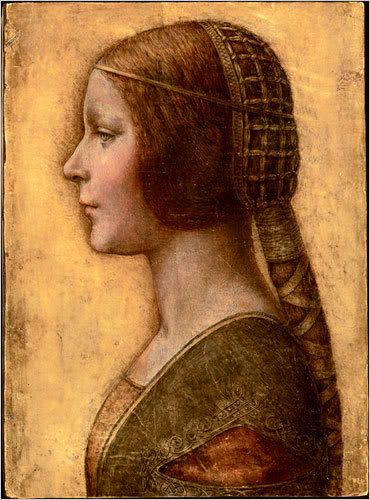
The New York Times reports that this painting, The Marriage Portrait of a Young Woman, which was initially believed to be a 19th-century German School portrait is now thought to be a Leonardo da Vinci original. The painting, which sold for $21,850 at a Christie’s auction back in 1998, has already fetched offers in excess of $50 million US dollars (from Russian billionaires, of course).
The work's owner, a Swiss Art Collector, decided to have some testing done on the piece after his friend, a Canadian art collecter, suggested that it might be a da Vinci:
The two collectors took the portrait to Lumiere Technology, a Paris-based company specializing in multispectral digital technology that had already digitized two works by Leonardo: the Mona Lisa at the Louvre and “Lady With an Ermine” at the Czartoryski Museum in Krakow, Poland.
“The first time that the owner gave me this drawing he didn’t say a thing; the author was secret,” said Pascal Cotte, Lumiere Technology’s chief technical officer.
Though Mr. Cotte carried out a series of tests on the work for nearly four weeks, he said, it did not take him long to come up with a name. “I went to the owner and said, ‘I have a feeling it’s a drawing by Leonardo,’ and he said, ‘We’re here for just that.’ ”
In June, Lumiere announced that its examination had led to the authentication of the work as a Leonardo.
Of course, skeptics would like to know how the experts at Christie's could make such a big mistake. At the very least, we now know that Christie's was way off base in terms of dating the work. The auction house experts believed the piece to be from 19th century, but independent Carbon-14 dating Swiss Federal Institute of Technology Zurich places the painting's date between 1440 and 1650.
While it is still unclear whether or not the work is a genuine Leonardo (scholarly opinions are mixed), what remains is that they made a rather sizable goof when they failed to pinpoint the date properly. It makes you wonder how many mistakes the experts make! I'm reminded of a scene in one of my favourite films, The Red Violin, where a concert violinist overlooks a priceless instrument when he's told that it's worthless. Too often, we see value in things because others (particularly individuals with cachet) believe are valuable. Prestige suggestion is often far more influential than whether we can genuinely appreciate an object's beauty.
At any rate, if I owned this painting, I would probably try to get rid of it a.s.a.p., before the critics changed their minds again!
Image courtesy of Lumiere Technology, used in accordance with Fair Use guidelines.
Posted by
Margaret
at
11:12 AM
7
comments
![]()
![]()
Labels: news
Friday, August 22, 2008
John Ruskin's Elements of Drawing
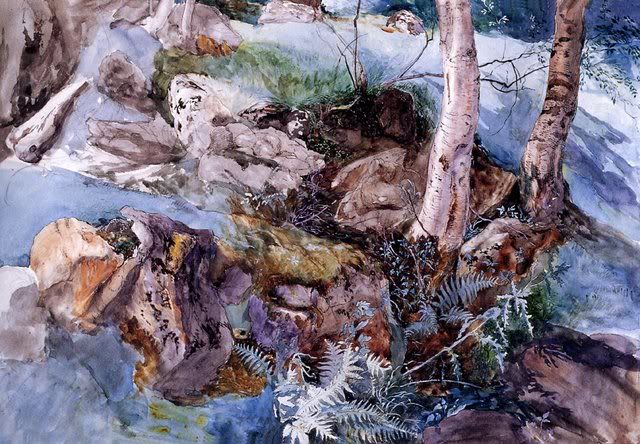
I first discovered John Ruskin through a badly battered edition of Elements of Drawing that was my constant companion from the ages of 10-16. I don't even remember where I found it the first time (did my mom buy it used? I have no idea), but at any rate I dragged it with me every time I went to sketch something. I loved it because it made it seem like drawing was something accessible to anyone, and it had great pictures that didn't intimidate me. Plus, it was written so simply that even a child could understand it, in spite of Ruskin's warning on the first page of the preface:
In the first place, the book is not calculated for the use of children under the age of twelve or fourteen. I do not think it advisable to engage a child in any but the most voluntary practice of art. If it has talent for drawing, it will be continually scrawling on what paper it can get; and should be allowed to scrawl at its own free will, due praise being given for every appearance of care, or truth in its efforts.
I remember feeling quite self important for using the book long before I was "supposed to", although looking back, I was basically engaged in "continually scrawling," rather than any serious study. At any rate, I just adored the book, which I took great delight in dragging to the woods with me whenever I wanted to go investigate sketching opportunities.
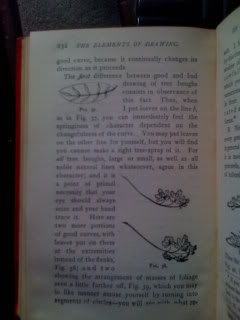
It wasn't until much later that I figured out that the John Ruskin who had written my handy little book was the same John Ruskin who had been one of the most famous art critics of the 19th century. I still remember reading about the Elements of Drawing--it was like a light bulb went on in my head. I ran to my bookcase, and sure enough, it was the same book! I was a little surprised--it seemed like such a simple little book.
151 years after it was published, The Elements of Drawing is still in print today, and it's no surprise. It's an amazing introduction to drawing and the world of art that is a perfect gift for anyone (plus, it has great pictures!). The entire book is constructed like a series of letters to an aspiring artist, and its conversational tone is a large part of its appeal. Plus, the reader is treated like an artist from the first page of a book--and is congratulated on tasks as simple as drawing a line. It's a classic book, and one I would recommend it to anyone, whether they draw or not!
The Ruskin watercolour shown above is Rocks and Ferns in a Wood at Crossmount, Perthshire, 1847.
Posted by
Margaret
at
12:12 PM
11
comments
![]()
![]()
Labels: ruskin
Thursday, August 21, 2008
Goodbye, Mr. Chips (1939)
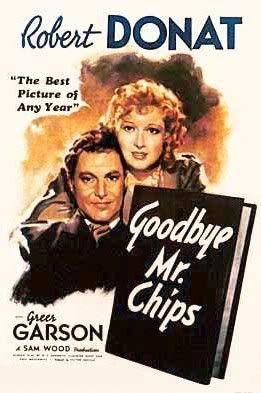
I love movies about great teachers. It's my weakness--Dead Poet's Society, The Emperor's Club--give me a movie about inspiring educators and I'm sure to love it. Goodbye, Mr. Chips is in a bit of a class by itself, however. It has been remade several times, but the original, starring Robert Donat as Charles Chipping, remains a masterpiece. The film garnered Donat an Oscar for best actor, and was nominated in pretty much every other category, including Best Picture (it lost to Gone with the Wind--and faced tough competition from the likes of the Wizard of Oz). Robert Donat's portrayal of "Mr. Chips" progression from a shy, young teacher to a school institution is masterful and remains a standout performance.
Goodbye, Mr. Chips is based on James Hilton's 1934 novel of the same name and tells the story of Charles Chipping, a Latin teacher at Brookfield, a prestigious boarding school. The story opens in 1870 with Chipping's arrival at Brookfield, just as the Franco-Prussian War was breaking out. Chipping is painfully shy and lacks confidence in his teaching abilities. His reticence makes him a target for the boys' rambunctious ways, nearly costing him his job. Determined to be successful at Brookfield, he transforms himself into a strict disciplinarian, earning the boys' respect at the cost of his popularity.
After losing an important promotion as the result of his unpopularity, Chipping goes on vacation in Europe, where he encounters his future wife Katherine while lost on a mountaintop. They marry, and through their relationship Chipping (she gives him his nickname)begins to soften. Sadly, tragedy strikes the couple very early in their marriage, but Katherine has helped Chips to see his relationship with the boys in a different light. He becomes very popular with the students and having Sunday afternoon tea with Chips becomes a beloved tradition.
One of the most pronounced themes in the film is the importance of continuing education in the midst of war. This is hardly surprising, given that Britain was deeply embroiled in World War II at the time of the film's release. After the outbreak of World War I, Mr. Chips is actually coaxed out of retirement at 65 to serve as headmaster (the position he was overlooked for years earlier). He does an excellent job boosting the student's morale in the midst of crisis. There is also a clear nostalgia for the Victorian era, and for the past in general (after all, Chips teaches a dead language!). This is also demonstrated by Chips' reluctance to adopt the "modern" Latin pronunciation (which nearly gets him forced into retirement!). There's a great scene where Chips tries to explain to the headmaster how much more glorious the old pronunciation of Caesar's words: "veni, vidi, vici" sounds compared to the new version (sounds like "weenie, weedy, wiki"). Although I was taught modern pronunciation, I must say I'm in agreement with Chips. There are, of course, aspects of the story that seem rather dated, such as the scene when Mr. Chips takes his cane to a rebellious youth. But I don't see this as a problem because the story is a historical piece and should be seen as such.
Sentimentalist that I am, I never fail to burst into uncontrollable tears at the film's close, when the dying Mr. Chips overhears his friends discussing what a shame it is that Chips never had any children of his own. He responds: "I thought you said it was a pity... pity I never had children. But you're wrong, I have. Thousands of them ... thousands of them ... and all boys." The story is a classic, and I particularly enjoy the way the film follows the protagonist through his entire life, and showing the audience the disappointments, tragedies and triumphs that make up Chips' life. It's also a movie that I appreciate more each time I see it. I remember that in high school, while I appreciated Mr. Chips, I preferred the flashier, more overtly sentimental Dead Poet's Society. I suppose my perspective has changed over time, because these days I'm attracted more to the subtleties of Goodbye, Mr. Chips.
Do any of you have other favourite movies about education you'd like to share? I always love hearing about new ones!
image courtesy Wikimedia
Fair use rationale:
1. This image is being used to illustrate the article on the movie in question and is used for informational or educational purposes only.
2. It is believed that this image will not devalue the ability of the copyright holder to profit from the original work.
3. No alternate, free image exists that can be used to illustrate the subject matter.
Posted by
Margaret
at
10:43 AM
7
comments
![]()
![]()
Labels: film
Wednesday, August 20, 2008
John William Inchbold "In Early Spring"
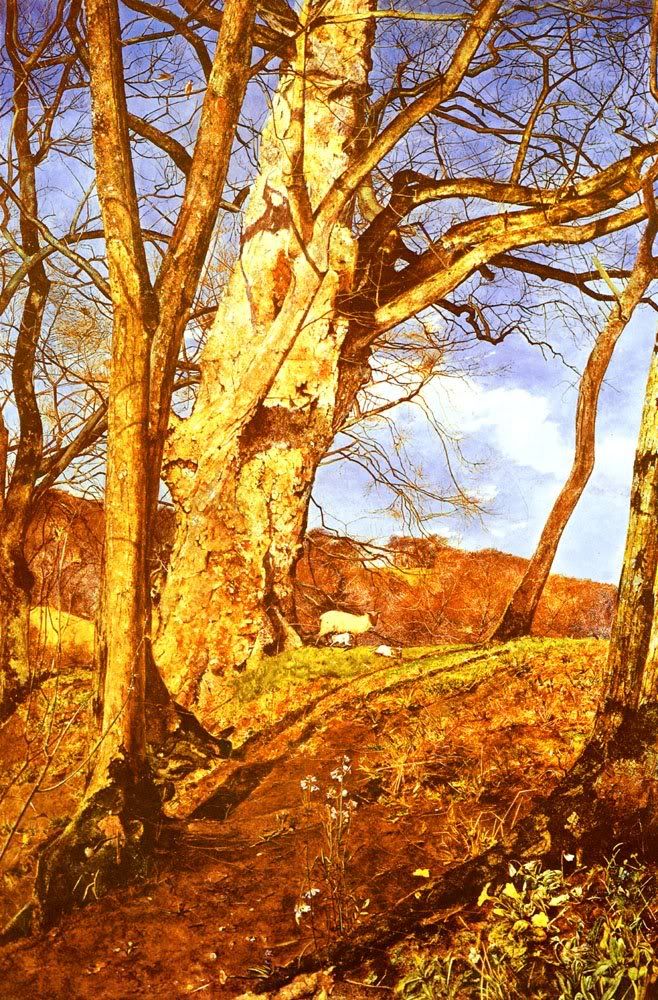
One of the most pleasurable things about writing this blog is that I'm constantly doing research. As a result, I often end up finding new artists that I'd never heard of before.
One of my recent discoveries is John William Inchbold, who painted A Study In March (In Early Spring)(shown above). A Study in March was inspired by William Wordsworth's poetry and was exhibited at the Royal Academy in 1855. The Spectator called it "a most delicious little piece—pure and perfect in its soft colour and unsurpassedly tender as a description of the season of early promise."
Inchbold's landscapes are extremely beautiful--(I've been looking everywhere for a copy of another of his paintings, The Chapel, Bolton ). It's a beautifully detailed rendering of Bolton Abbey done in the Pre-Raphaelite style. If anyone finds a public domain copy of the image on the web, let me know!
John William Inchbold grew up in Leeds, where his father worked in the newspaper business. John William left for London in 1846 in order to study lithography with the firm of Day & Haghe. Interestingly, while his obituary in The Athenaeum claims Inchbold studied at the Royal Academy, his name does not appear anywhere in their records, so if he studied with the Academy, it was in an unofficial capacity!
Inchbold showed his watercolours at the Society of British Artists in 1849 and 1850 and at the Royal Academy in 1851. In 1852 he met Dante Gabriel Rossetti and from that point onward his style changed dramatically. He began to draw heavily on the poems of Wordsworth, and his oil painting of the Chapel, Bolton (exhibited at the Royal Academy in 1853) shows Pre-Raphaelite influences, such as extreme attention to detail). The next year he produced another painting of Bolton Abbey, this time with a deer prominent in the foreground. Both paintings are based on William Wordsworth's poem "The White Doe of Ryleston."
Inchbold seems to have been a rather dull fellow (Rossetti complained that he was boring), at least in comparison to the rest of the Pre-Raphaelite Brotherhood, so that's probably why he's not as well known as his compatriots. At any rate, I think his paintings are just lovely.
Source consulted for Inchbold bio: Oxford Art Online
Image courtesy of Art Renewal International
Posted by
Margaret
at
11:20 AM
8
comments
![]()
![]()
Labels: pre-raphaelites
Tuesday, August 19, 2008
iTunes U
I've written about a couple of Apple products lately, and I think it's a slippery slope: you download iTunes (it's useful, right?), then you buy an iPod (everyone has one!), then you fall for an iPhone. Apple: you had me at iTunes. It's only a matter of time before I go all the way and start using a mac. So, pardon me for my enthusiasm, but I thought I'd share a bit of my experiences with Apple's iTunes U.
iTunes U was launched late last year by Apple in cooperation with a number of leading universities and other educational providers and is completely free and available to anyone. You can watch videos and listen to audio recordings from MIT, University College London and other great schools (in addition to content from Museums like MoMA).
I started by downloading a video series from the UK's Open University "Art and its Histories." There were some great segments, though overall the program lacked continuity. After perusing some other video offerings from other Universities, I came to the conclusion that the video aspect of iTunes U is a bit like a better organized version of YouTube. The content is great, and obviously more reliable because it is offered by the universities themselves. Unfortunately, there's a lot of work to be done before it lives up to its name--it's no "U" until it's a little better put together. That being said, I should mention that the audio podcasts are great, although I believe video has a lot more potential if it's properly organized. I'm optimistic that the organization will improve as time goes by--it's amazing how much content is available already.
One neat thing I noticed was that a lot of schools are having students record their presentations as podcasts, which is a great way to teach students about the value of their research. My only concern would be the quality of their work, but I found most of it to be quite good. I must confess that when it comes to the concept of offering a free, reliable, quality source for educational content, I'm blown away. Apple has a really good idea here. It's really nice to see information being shared in this way--it's the web at its best.
One of my first thoughts after watching Apple's tutorial on iTunes U was that this would be an excellent resource for homeschooling. I was educated at home until my third year of high school, which I think conditioned me to look for new ways to learn on my own. I've always been somewhat of a natural self-starter when it comes to learning. I basically just love learning new things, and this program will be perfect for others who really just enjoy learning. At the very least, it's nice to have some quality educational programming to use with your iPod or iPhone, rather letting your brain turn to mush while watching the music video du jour. And since I'm guilty of constantly cramming my head with pop culture slush, it makes me feel better to know I have the chance to expiate my sins with an informative lecture or two.
You can read more about Apple's iTunes U project on their website.
Posted by
Margaret
at
12:09 PM
4
comments
![]()
![]()
Labels: technology
Monday, August 18, 2008
Possessed: Announcing a New Pre-Raphaelite Musical!
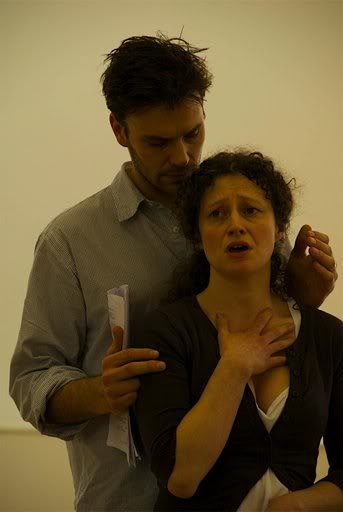
What do you get when you combine Pre-Raphaelite art, an infamous love affair, and music? Possessed is a new musical that examines the life of Jane Burden, from her discovery by Dante Gabriel Rossetti to her meteoric rise to become one of the most popular and iconic models of her age, almost omnipresent in the paintings of the Pre-Raphaelites, particularly those of Dante Gabriel Rossetti. Possessed focuses on the relationship between Jane, her husband William Morris ("Topsy") and Rossetti. The full cast also includes Bessy, the Morris's housekeeper, Lizzie Siddal, Mr. Carter (the foreman of Morris & Co.), and Jane and William Morris’ two daughters, Jenny and May.
Playwright Teresa Howard became inspired to research Jane’s story following a William Morris exhibit at the Victoria and Albert Museum back in 1996. For Possessed, Howard (who has written a number of other plays) has teamed up with composer and arranger Steven Edis, who has written and arranged music for numerous theatre and television productions.
Not surprisingly, art plays a central role in the production. During the course of the musical, stained glass windows depicting the tale of Tristan and Isolde are constructed on stage, symbolising the close relationship between art and life and alluding to the link between the story being played out on stage and the story of Tristan and Isolde.
The musical was presented on April 27 at the Oxford Playhouse and was a great success, generating a great deal of interest in the project. Hopefully full scale production of the musical will begin at the end of next year...I can’t wait!
To learn more about this production, visit the The musical's official website. For up to the minute news and information, visit their blog, Putting it Together.
Rehearsal photo of Anna Francolini as Jane Morris and Joseph Millson as Dante Gabriel Rossetti
Rehearsal Photo by Charles Girdham © 2008, reprinted with permission of Teresa Howard
Posted by
Margaret
at
5:49 AM
6
comments
![]()
![]()
Labels: jane morris, lizzie siddal, music, news, pre-raphaelites, reviews, rossetti, waterhouse, william morris
Friday, August 15, 2008
Google's Knol Project
Google's Knol Project has received a great deal of publicity lately. Most of the articles I've read so far suggest that Knol is simply Google's attempt to crush Wikipedia.
I'm a huge fan of Wikipedia, which is pretty unusual for someone who has done a lot of teaching. Most teachers detest Wikipedia because students often use Wikipedia as if it were an authoritative source. I consider Wikipedia a useful place to get a general idea about a subject, but the articles there should be taken with a grain of salt, since there's always a chance someone might have gotten into an article and messed with it. Since I like Wikipedia, I was somewhat alarmed by the idea that Google might use the Knol project to steal Wikipedia's thunder. So I decided to investigate a little further and write a few of my own Knols as an experiment. I came to the conclusion that while many claim Knol is simply Google's attempt to supplant Wikipedia, it's quite different for a number of reasons:
1. "You specify the level of collaboration you want with the community"--in other words, unlike at Wikipedia, where you're at the mercy of editors higher up the chain, you can preserve the integrity of your work (assuming your work has some integrity).
2. You can write about a topic even if someone else has written about the same topic before. How many times have you run across an article at Wikipedia and you thought you could do better? Well, with Knol you can.
And as a blogger at the L.A. Times reported, Google also puts Knols through a quality control filter, meaning that when write a Knol, it won't necessarily be accessible via search engines--Google will basically make it "invisible" if it doesn't pass their screening process. This bothers some people, who seem to consider it a form of censorship, but since I prefer not to have to wade through piles of junk, I think it's a useful tool.
I've already written a number of Knols myself--one on the Pre-Raphaelite Brotherhood, which I'm not all that proud of, and one on St. Patrick and the Irish Church, which is pretty far removed from the subject of this blog, but is probably my best knol. It was an old paper from University that I figured I would probably never realisticaly publish, so turning it into a Knol was a great way to keep my paper alive while getting a little publicity at the same time.
I have to admit that I'm excited about the Knol project because it seems fresh and new. There are definitely some kinks, such as the problems Google's been having with people using Knols as spamming tool (blogger Jonathan Bailey has actually gone so far as to call Knols "The Future of Spam." ). I'm sorry to say that I've personally witnessed a plethora of duplicate content in Knols already, which is pretty disappointing, considering that Google is supposed to be pretty savvy about how to filter that stuff out.
I still have my reservations about the project, but so far it seems like a great opportunity for people to share their knowledge without having to sacrifice their rights to their original work. I would especially recommend it to anyone who, like me, has reams of old university papers around the house that are too big to put on a blog.
Has anyone else experimented with writing Knols so far? What was your experience like?
Posted by
Margaret
at
7:00 PM
6
comments
![]()
![]()
Labels: reviews, technology
Wednesday, August 13, 2008
"The Scapegoat" by William Holman Hunt

As promised, this is the last of the William Holman Hunt goat/sheep series. We started with The Hireling Shepherd, and yesterday we examined Our English Coasts. Today I'll be looking at The Scapegoat.
William Holman Hunt left London for the Holy land to find inspiration for his work on January 13, 1854. When he arrived in Jerusalem, he began reading the book of Leviticus and was particularly impressed by its account of the Day of Atonement. Leviticus records how on the Day of Atonement, the Jews were instructed to take two goats and sacrifice one in front of the temple and drive the other outside of the city to its death--symbolically carrying the sins of the people away with it. Hunt immeadiately connected the tale to the story of Christ's Passion, and thought it would make a fantastic subject for his next painting.
In spite of the safety concerns in the region (in the 1850s, just like today, there was a lot of unrest around Jerusalem, but a lot less security!), Hunt set out into the countryside to start painting The Scapegoat, using the Dead Sea as his backdrop. Hunt later recorded his adventures in his book Pre-Raphaelitism and the Pre-Raphaelite Brotherhood (1905):
I suspended my painting and looked from beneath my umbrella, until suddenly the
deeshman [armed tribesmen] emerged from behind the mountain within half a
furlong of me where they halted. The horsemen had their faces covered with black
kufeyiahs, and carried long spears, while the footmen carried guns, swords and
clubs...I continued placidly conveying my paint from palatte to canvas,
steadying my touch by resting the hand on my double-barrelled gun. I knew that
my whole chance depended upon the exhibition of utter unconcern, and I continued
as steadily as if in my studio at home...
It certainly sounds as if Hunt had an exciting time! (At the very least, he was a great story teller!). I love how he portrays himself as the romantic hero.
Nevertheless, when local tensions escalated, Hunt was forced to abandon his field work to finish the painting in his studio. But in order to preserve the integrity of his painting, he took samples of the mud and salt from the Dead Sea back to his studio and purchased sheep and goat skulls and a full camel skeleton to add into the background of the painting (for more info, see this article from the Liverpool Museum about the painting). There weren't very many laws to protect animals in those days, and so Hunt took a live goat to his studio and made it stand for hours in a tray of dried mud so that he could paint it as accurately as possible. No wonder the goat looks so miserable! No word on what happened to the goat after the painting was completed.
Sadly, for all of Hunt's attention to detail, The Scapegoat was poorly received when it was shown in London. Although Hunt provided a note "See Leviticus, xvi" ('And the Goat shall bear upon him all their iniquities unto a Land not inhabited'), members of the academy complained that the symoblism of the painting was too hard to understand. Others felt that it was blasphemous to use a goat as an allegory for Christ's Passion.
Nevertheless, at least one member of the Royal Academy was impressed:
I think we shall see cause to hold this picture as one more truly honourableFortunately for Hunt, the controversy didn't discourage buyers, and the painting was sold for 450 guineas.
to us, and more deep and sure in its promise of future greatness in our schools
of painting, than all the works of "high art" that since the
foundation of
the Academy have ever taxed the wonder, or weariness, of
the English Public.
--Academy Notes, 1856, 14.64 in Hewison
Source consulted: Hewison, Robert. Ruskin, Turner and the Pre-Raphaelites. London: Tate Gallery Publishing, 2000.
Image courtesy wikimedia commons
Posted by
Margaret
at
9:44 AM
9
comments
![]()
![]()
Labels: pre-raphaelites, william holman hunt
Tuesday, August 12, 2008
William Holman Hunt "Our English Coasts"
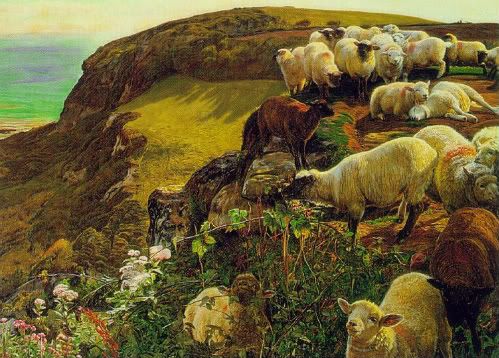
In the wake of the popularity of the The Hireling Shepherd, William Holman Hunt was asked by Charles T. Maud to paint another picture featuring the wayward sheep. In 1852, William Holman Hunt began work on Our English Coasts (also known as Strayed Sheep).
Hunt used the cliffs of Fairlight, east of Hastings, as the background for the work. You will recall that William the Conqueror, a Norman (French) invader, triumphed over the English forces at the battle of Hastings in 1066, forever changing the course of English history and introducing feudalism into England.
Hunt's choice of Hastings as the setting for his painting was certainly not a coincidence. Symbolism was so important to the Pre-Raphaelites that it seems very unlikely that Hunt would have chosen to portray a flock of "sheep" wandering precariously over the cliffs near Hastings if he hadn't intended to convey a deeper message. As a result, many have interpreted the painting as symbolic of fears of the French invading England. Interestingly, the Duke of Wellington, Arthur Wellesley, famed for his defeat of Napoleon at the Battle of Waterloo, died while Hunt was in the process of completing the painting.
The painting is also reminiscent of Alfred Lord Tennyson "Ode on the Death of the Duke of Wellington," especially these two lines:
Remember him who led your hosts;
He bade you guard the sacred coasts (VII, 21-22)
Whatever the deeper meaning behind the painting, it left a significant impression on art critic John Ruskin (who had defended Hunt's earlier work as well). When Our English Coasts was first exhibited, Ruskin praised the painting highly in his lecture series, The Art of England. Ruskin remarked that "it showed to us for the first time in the history of art, the absolutely faithful balances of colour and shade by which actual sunshine might be transposed into a key in which the harmonies possible with material pigments should yet produce the same impressions upon the mind which were caused by the light itself"(33.272-3).
As with Hunt's other early paintings, what is striking about this work is the near-photographic detail. The flowers and leaves in the background are done with incredible precision. Even the veins in the sheep's ears are lifelike! It's a really spectacular composition on so many levels. One of the things I really like about this painting is that it reminds us that the Pre-Raphaelites didn't just paint pictures of knights and ladies! There are so many beautiful landscapes done by artists in the Pre-Raphaelite vein that deserve more attention.
Posted by
Margaret
at
10:09 AM
5
comments
![]()
![]()
Labels: pre-raphaelites, ruskin, william holman hunt
Sunday, August 10, 2008
Dante's Inferno to be released September 23rd
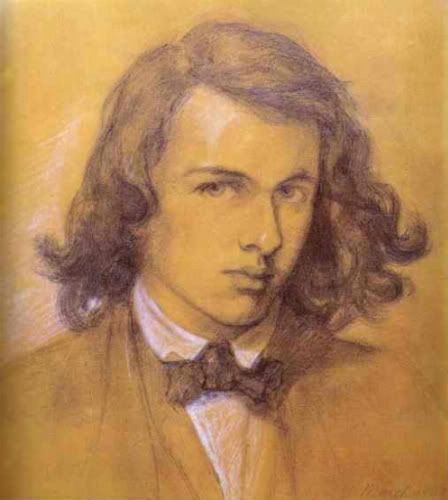
Several of you have made comments about the 1967 BBC Rossetti documentary, "Dante's Inferno." After doing a bit of research, I discovered that it will be released on DVD for the first time this September.
The box set will be available at Best Buy September 23rd for $69.99
Synopsis of Dante's Inferno:
One of director Ken Russell's earliest films, Dante's Inferno is a made-for-TV biopic about the British poet and painter Dante Gabriel Rossetti (Oliver Reed), who was a founder of the Pre-Raphaelite Brotherhood during the late 1800s. The style was influenced by romanticism and Renaissance painters. Other founding members of the movement were William Morris (Andrew Faulds), Edward Coley Burne-Jones (Norman Dewhurst), and John Everett Millais (Derek Boshier). Iza Teller plays Dante's sister, the poet Christina Rossetti. Judith Paris plays his wife, Elizabeth, who was driven to suicide.
~ Andrea LeVasseur, All Movie Guide
The film is being released as part of a series of BBC documentaries directed by Ken Russell. The DVD, entitled "Ken Russell at the BBC" focuses on biopics of famous artists. Titles include:
Elgar (1962)
The Debussy Film (1963)
Always on Sunday (1965)
Isadora Duncan (1966)
Dante's Inferno (1967)
Song of Summer (1968)
Dance of the Seven Veils (1970)
Posted by
Margaret
at
12:55 PM
12
comments
![]()
![]()
Saturday, August 9, 2008
BBC Announces Pre-Raphaelite Drama

For those of you who can't get enough of the Pre-Raphaelites, the BBC has announced that a new drama is in the works that will focus on the lives and loves of the revolutionary group of English painters.
The miniseries, entitled "Desperate Romantics," will trace the development of the Brotherhood and their unique approach to art. Variously described by its creators as "Entourage with Easels" and "the Boy Band of the 19th century," the story will be looking at the sexier side of the Pre-Raphaelites. I have some deep reservations with the project, as I did with the latest BBC reincarnation of Brideshead Revisited, but I'm reserving judgement for the time being, except to point out that there was much more to the Pre-Raphaelites than "Entourage with Easels!"
Aside from the 1975 small-screen adaptation about the Pre-Raphaelites entitled The Brotherhood (starring Ben Kingsley as Rossetti), there really haven't been any films about the Pre-Raphaelites, probably because the art of the Pre-Raphaelites was very unpopular after World War II. Nevertheless, in reading about the lives of the Pre-Raphaelites, there's so much fodder for screenwriters that rather I'm shocked we haven't seen more film adaptations of their story.
The script for the BBC miniseries is written by Peter Bowker, whose credits include Blackpool and Shakespeare Re-Told. He's also penned the script for a new ITV production of Wuthering Heights, due out in the fall of this year.
Filming for the series "Desperate Romantics" is set to begin in 2009. Look for more information to follow!
Thanks to Stephanie Pina, at Pre-Raphaelite Sisterhood, for bringing this story to my attention!
Posted by
Margaret
at
11:39 AM
6
comments
![]()
![]()
Labels: film, news, pre-raphaelites
Thursday, August 7, 2008
William Holman Hunt "The Hireling Shepherd"

The subject of William Holman Hunt's The Hireling Shepherd was actually taken from William Shakespeare's King Lear. In the play, the character Edgar sings a song about a shepherd neglecting its flock, and Hunt used the song as an inspiration for his work.
King Lear Act III, Scene VI.41
Edgar: "Sleepest or wakest thou, jolly shepherd?
Thy sheep be in the corn;
And for one blast of thy minikin mouth,
Thy sheep shall take no harm."
If the song is rather reminiscent of "Little Bo-Peep," it's no accident. King Lear is actually referred to as "Bo-Peep" by the court jester earlier in the play (I.iv)
Fool: Then they for sudden joy did weep,
And I for sorrow sung,
That such a king should play bo-peep,
And go the fools among.
In King Lear, the shepherd analogy is used to show that the King has been distracted from his calling as "shepherd" to his "flock."
William Holman Hunt actually wrote a letter on this subject that I found on Shakespeare Illustrated--a great website that connects 19th century paintings to their roots in Shakespeare's work.
Shakespeare's song represents a Shepherd who is neglecting his real duty of guarding the sheep: instead of using his voice in truthfully performing his duty, he is using his "minikin mouth" in some idle way. He was a type thus of other muddle headed pastors who instead of performing their services to their flock--which is in constant peril--discuss vain questions of no value to any human soul. My fool has found a death's head moth, and this fills his little mind with forebodings of evil and he takes it to an equally sage counsellor for her opinion. She scorns his anxiety from ignorance rather than profundity, but only the more distracts his faithfulness: while she feeds her lamb with sour apples his sheep have burst bounds and got into the corn. It is not merely that the wheat will be spoilt, but in eating it the sheep are doomed to destruction from becoming what farmers call "blown." (Quoted by Landow, 39).
I really enjoy the humour in this painting. At first glance, the viewer is presented with an idyllic setting--rolling hills dotted with sheep, a happy young couple, a winding stream and a field of golden wheat.
But on closer inspection, it turns out that a number of the sheep are lying on the grass, unable to get up! You can see one of the sheep on the left of the canvas is even helplessly flailing his legs! One of the sheep has wondered across the stream and is eating barleycorn (note: in King Lear, Edgar refers to the sheep being in the corn--in Shakespeare's day, corn meant barleycorn--there was no maize until after the European discovery of the Americas), which probably isn't good for him, and refers directly to the song from King Lear. The lamb resting in the girls lap is eating green apples, which are probably making him sick as well. The girl, who at first blush seemed to be relaxing in the grass happily with the shepherd boy, actually looks a little uneasy. The shepherd boy is showing her something--a death's head moth! He's also totally neglecting his work and seems oblivious to what is happening to his flock.
The painting was first exhibited in 1851.
Posted by
Margaret
at
11:51 AM
1 comments
![]()
![]()
Labels: pre-raphaelites, shakespeare, william holman hunt
Tuesday, August 5, 2008
William Holman Hunt "A Converted British Family Sheltering a Christian Priest"
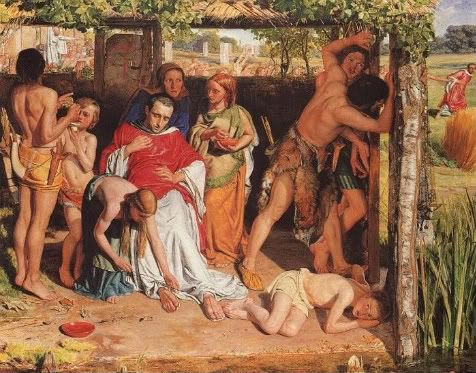
The first painting to be exhibited after the public revelation of the meaning of "PRB" was William Holman Hunt's "A Converted British Family Sheltering a Christian Priest from the Persecution of the Druids." The title of the painting is rather self-explanatory, and like many of the early Pre-Raphaelite works, it dealt with religious themes through a rather syncretistic lens.
You might also recognize the face of the girl on the right of the priest: it's Lizzie Siddal, although Holman Hunt has portrayed her rather differently than Rossetti generally does. This painting caused an uproar when it was first displayed because of the "nudity" of some of the figures. This might have merely been a reaction to the fact that the public was now aware of the existence of the Pre-Raphaelites and did not approve of the Brotherhood.
This painting is filled with overt Christian symbolism. You can see that thorns are being removed from the priest's clothing and the women are preparing to bathe his feet--an allusion to Christ on the cross. Immediately above the priest is a red cross that indicates that the family sheltering the priest are Christian converts. A lamp burns just below, highlighting the fact that, in time, things will change for Christians in England. Grapes are being grown on the arbour above, hinting at the wine used at mass (one of the young boys on the left hand of the canvas is drinking from a chalice). At the right of the canvas, a net rests on one of the beams supporting the roof. Interestingly, while nets are symbols of Christianity (Christ made his disciples "fishers of men"), they also are a reference to the fact that this family has abandoned some key Druidic practices. The Druids believed fish were sacred and did not allow fishing.
Posted by
Margaret
at
12:17 PM
6
comments
![]()
![]()
Labels: lizzie siddal, pre-raphaelites, william holman hunt
Friday, August 1, 2008
Art History Carnival, Issue 2
The second issue of the art history carnival has been a long time coming, but it's finally here! There's something for everyone in this issue, as the posts featured in this edition cover a wide spectrum of artistic periods and mediums (one writer even focuses on art in pre-history!). Here you will find posts on everything from paintings to film to architecture. Everyone familiar with this blog knows I'm quite a fan of the Arts and Crafts Movement and the Pre-Raphaelites, so you'll excuse me for pointing out that one of the greatest triumphs of the Arts and Crafts Movement was the way it opened up the definition of art and freed people to examine the creative spirit from a multitude of different angles.
You may recall that the Arts and Crafts movement was, in a large part, an effort to expand the definition of art to include more than just paintings and sculpture. William Morris and the Arts and Crafts Movement effectively destroyed the hierarchy of genres within art, and I think this carnival is in many ways a celebration of this. It is therefore quite appropriate that this collection of posts celebrates so many different facets of art and beauty.
Art History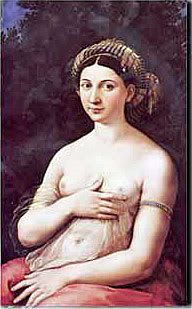 Judith Weingarten has written a great piece on the surprise connections between Raphael's 1518 painting, La Fornarina, and a lively giraffe (right) drawn on a papyrus in the late first century BC -- the so-called Artemidorus Papyrus. It's a little mystery/art history lesson that will not disappoint, and I really think you'll all enjoy it!The Baker's Daughter and the Artemidorus Papyrus is posted at Zenobia: Empress of the East.
Judith Weingarten has written a great piece on the surprise connections between Raphael's 1518 painting, La Fornarina, and a lively giraffe (right) drawn on a papyrus in the late first century BC -- the so-called Artemidorus Papyrus. It's a little mystery/art history lesson that will not disappoint, and I really think you'll all enjoy it!The Baker's Daughter and the Artemidorus Papyrus is posted at Zenobia: Empress of the East.
A. Lee, fine art painter examines the nature of Piet Mondrian’s Abstract Art. For those of you who are not familiar with his work, Piet Mondrian was an influential Dutch Abstract painter of the first half of the 20th Century. Learn more about the soulful essence of his art by reading her delightful post at eArtFair .com - Fine Contemporary Art.
JULIET SMALL ERNST presents BIOGRAPHY AND MYTH posted at WE ARE INDEPENDENTLY WEALTHY. Her post examines the biography of Mary Meerson, partner of Cinematheque founder Henri Langlois, and her attitude towards the past.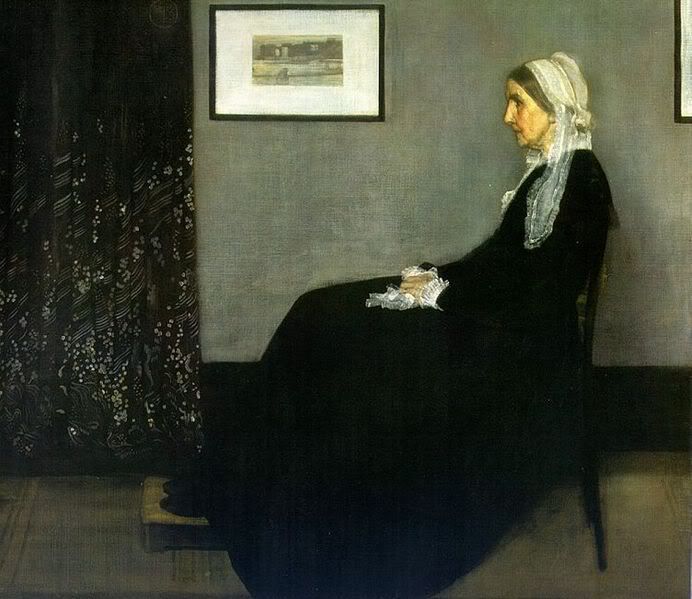 Nandita has written a review of Whistler's Mother posted at Lines in Books. It can be difficult to write about paintings that are as ubiquitous as this one, but I found Nandita's take quite interesting.
Nandita has written a review of Whistler's Mother posted at Lines in Books. It can be difficult to write about paintings that are as ubiquitous as this one, but I found Nandita's take quite interesting.
My intro to this carnival gives away the fact that my definition of art is rather fluid. In my view, poetry is just as much an art as painting, so when I received this submission about the death of proto-romantic poet Andre Chenier (back in 1794), I knew that I had to include it in the carnival. 1794: Andre Chenier, poet is a great blog post found at ExecutedToday.com. Be sure to scroll down the page when you get to the article--Jason has included a YouTube clip from the 19th century Andre Chenier opera that is simply fabulous.
Art News and Exhibits
Kerry of The Ten O'Clock Scholar has written a post entitled Art Links for Homeschoolers , which describes several art exhibits that are showing on the East Coast this summer.
Sarah has written a directory of NYC museum free/pay-what-you-wish days posted at SARAHSPY. This is really useful information! When we were in France this sort of thing was invaluable. It can get really expensive to pay at every museum, especially when you are on vacation and hitting multiple museums per day. Thanks, Sarah!
Philosophy of Art
Gail Kavanagh's attempts nothing less than an examination of the origins of the creative spirit in her blog Creative Fire. For this carnival I'm including one of her meditations on art in prehistory entitled Enter the Neolithic. Be sure to take a look at some of her other educational writings on "Creative Fire" as she traces the history and prehistory of art.
Reviews AdmirableIndia.com presents Trip to Chikmagalur: Day 1: Chennakesava temple at Belur, Hoysaleswara temple at Halebid and Castle Rock Homestay, Chikmagalur posted at AdmirableIndia.com. There are some great pictures here of spectacular old Indian architecture! I'm not sure about the exact dating of these structures, so if anyone knows, leave a comment! **EDIT** The temple dates back to 12th century. The exact date of construction is believed to be 1117AD. (Thank you, admirableindia!.
AdmirableIndia.com presents Trip to Chikmagalur: Day 1: Chennakesava temple at Belur, Hoysaleswara temple at Halebid and Castle Rock Homestay, Chikmagalur posted at AdmirableIndia.com. There are some great pictures here of spectacular old Indian architecture! I'm not sure about the exact dating of these structures, so if anyone knows, leave a comment! **EDIT** The temple dates back to 12th century. The exact date of construction is believed to be 1117AD. (Thank you, admirableindia!.
Take a look at Bangalore to Mysore on Bike: Day 1: Part 1: Srirangapatna for some more great photos of Indian architecture.
Posted by
Margaret
at
5:04 AM
9
comments
![]()
![]()
Labels: blog carnival

